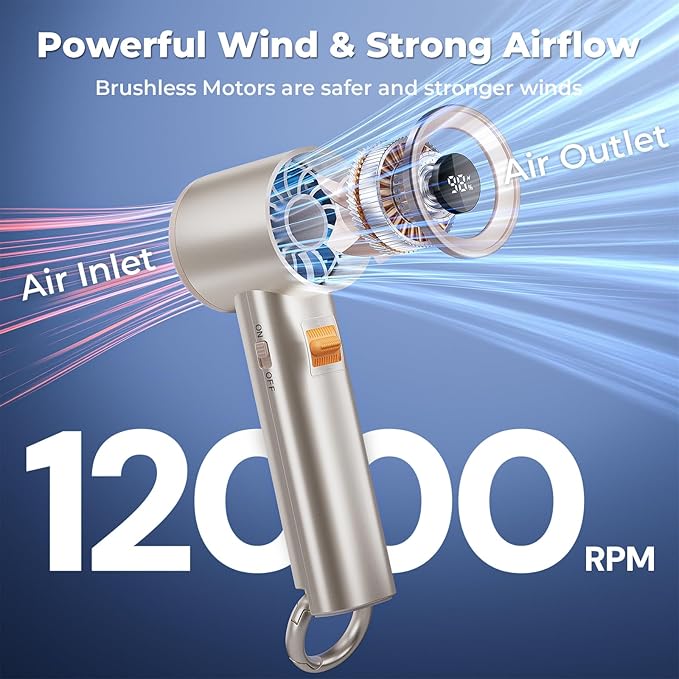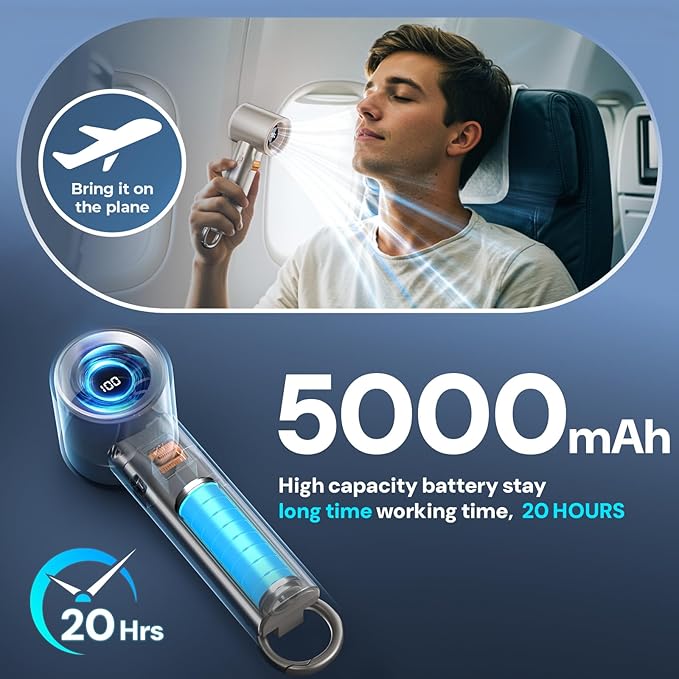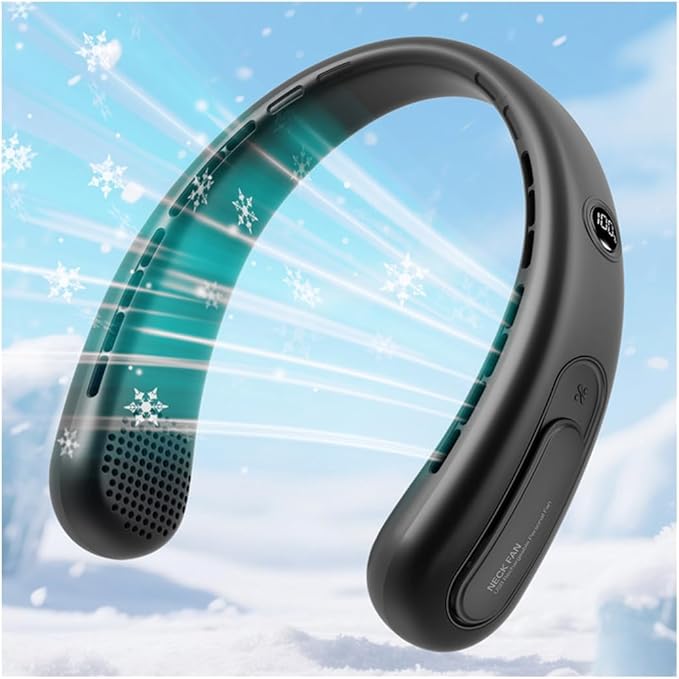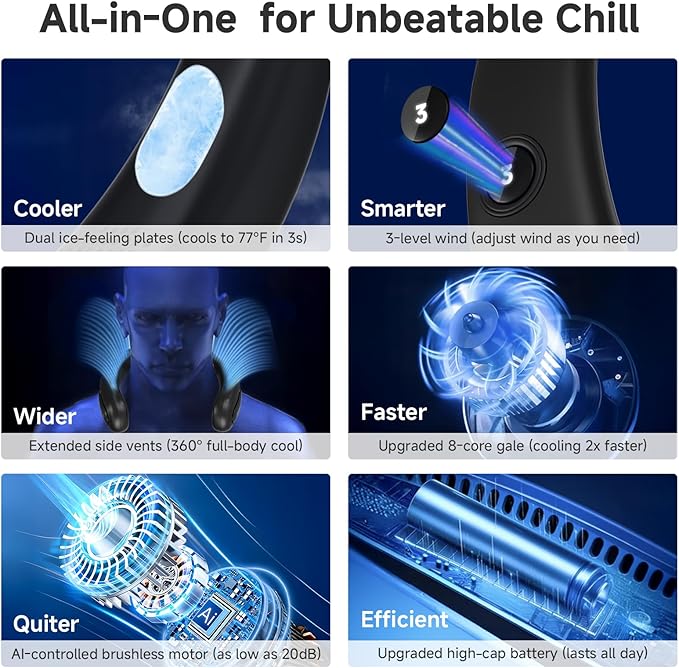Introduction: Choosing the Right Portable Fan for Personal Cooling
With the rising demand for personal cooling solutions, especially during outdoor activities or in hot environments, portable fans have gained immense popularity. Among the myriad options available, two stand out for their innovative designs and features: the Portable Neck Fan and the Portable Handheld Turbo Fan for Outdoor. Both claim to offer convenience, effective cooling, and portability, but each caters to slightly different user needs and preferences.
This comprehensive, deeply analytical comparison aims to dissect every critical aspect of these two devices, helping readers make an informed decision tailored to their lifestyle and requirements. We will explore design philosophies, performance metrics, features, usability, value for money, and much more, supported by detailed comparison tables and thorough evaluations.
Design and Ergonomics: Wearable Comfort vs. Handheld Portability
The Portable Neck Fan embraces a hands-free design philosophy, engineered to rest comfortably around the user’s neck. Constructed with lightweight, flexible materials, it offers ease of use during prolonged wear, allowing full freedom of hand movement. Its U-shaped ergonomics are crafted to balance weight evenly, reducing neck strain. Adjustable fan heads enable directional airflow customization, an important factor for personalized cooling.
Conversely, the Portable Handheld Turbo Fan emphasizes compactness and mobility. Its design is centered on a robust grip with textured surfaces to prevent slipping during active use. The handheld nature inherently requires manual operation, but this is offset by a turbo mode that boosts airflow significantly when needed. The fan’s size is optimized for easy stowing in backpacks or even large pockets, making it ideal for on-the-go cooling with quick accessibility.
Both designs have merits; the neck fan excels in hands-free convenience and continuous wear comfort, while the handheld fan shines in quick-response cooling and ease of directional control. The choice between the two largely hinges on user activity and preference—whether constant, subtle cooling is desired or intense, sporadic airflow bursts are preferred.
Performance and Airflow Analysis
Performance is paramount in any cooling device. The Portable Neck Fan is equipped with dual fans capable of adjustable speed settings, delivering smooth and consistent airflow around the neck and face. Its airflow volume reaches up to approximately 4.5 cubic meters per minute, sufficient for cooling during mild to moderate heat exposure.
In contrast, the Portable Handheld Turbo Fan leverages a high-speed motor capable of producing a turbo airflow mode that can reach upwards of 7 cubic meters per minute, offering intense bursts of cooling air. This makes it more effective for short-term relief in high-temperature scenarios. However, this power comes with trade-offs, including increased noise levels and reduced battery longevity at turbo speeds.
Battery capacity and efficiency also play critical roles. The neck fan typically houses a 2000mAh rechargeable battery, delivering up to 6-8 hours of operation depending on speed settings. The handheld turbo fan, while often equipped with a smaller battery (around 1500mAh), compensates with faster motor speeds but yields shorter runtime at peak performance.
| Feature | Portable Neck Fan | Portable Handheld Turbo Fan |
|---|---|---|
| Airflow Volume | Up to 4.5 m³/min | Up to 7 m³/min (Turbo Mode) |
| Speed Settings | 3 Adjustable Speeds | 3 Speeds + Turbo Mode |
| Battery Capacity | 2000mAh | 1500mAh |
| Battery Life | 6-8 hours (varies by speed) | 3-5 hours (normal), 1-2 hours (turbo) |
| Noise Level | Low to Moderate (45-55 dB) | Moderate to High (55-70 dB) |
| Charging Time | 2.5 hours | 2 hours |
Material Quality and Build Durability
The neck fan’s build utilizes a blend of silicone and ABS plastic, offering flexibility and resilience against minor impacts and regular bending. Its components are carefully sealed to resist sweat and light moisture, enhancing durability during outdoor use. The fan blades are enclosed within protective grilles that prevent hair or skin from accidental contact.
The handheld turbo fan, designed for more rugged outdoor use, incorporates robust ABS plastic with a textured grip and reinforced internal motor housing to withstand occasional drops. It often features a removable cover for easy cleaning of dust and debris from the blades. However, due to the motor’s higher speeds, some vibration is perceptible, which might impact long-term component wear.
Feature Set and Usability Enhancements
The Portable Neck Fan includes intelligent features such as a built-in LED battery indicator, USB-C fast charging, and quiet operation mode. Its adjustable fan heads allow users to direct airflow precisely, and the device automatically pauses when bent excessively, preserving motor health.
The handheld turbo fan compensates with a more aggressive feature set: turbo boost mode, battery status LEDs, USB charging, and a compact stand allowing it to function as a desktop fan when not held. Additionally, some models incorporate splash resistance, making them suitable for light rain or sweaty workout sessions.
| Feature | Portable Neck Fan | Portable Handheld Turbo Fan |
|---|---|---|
| Hands-Free Use | Yes (neck wearable) | No (handheld only) |
| Adjustable Fan Direction | Yes, dual fan heads | No (fixed fan direction) |
| Turbo Mode | No | Yes |
| Battery Indicator | LED indicator | Multi-LED status |
| Charging Port | USB-C | USB-C |
| Noise Control | Quiet mode available | Noisy at turbo |
| Water Resistance | Light splash resistant | Light splash resistant |
| Additional Stand Feature | No | Yes (desktop mode) |
Value for Money: Pricing and Cost Efficiency
Pricing plays a significant role in the final purchasing decision. As per current market listings, the Portable Neck Fan is priced moderately, reflecting its hands-free convenience and longer battery life. Its price point offers good value for those prioritizing continuous, wearable cooling during tasks or exercise.
The Portable Handheld Turbo Fan tends to be priced slightly lower, catering to users who need short bursts of high-powered cooling without the bulk of a wearable device. Its pricing is competitive, especially when considering its turbo mode and versatile desktop stand functionality.
Long-term cost efficiency also involves durability and battery lifespan. The neck fan’s slightly larger battery and quieter motor may translate into better endurance and less frequent charging, whereas the turbo fan’s higher motor load may demand more frequent battery replacements or cautious use to extend lifespan.
Final Verdict: Which Portable Fan Suits Your Needs Best?
Both the Portable Neck Fan and the Portable Handheld Turbo Fan for Outdoor are excellent personal cooling devices with distinct strengths. For users who value hands-free operation, continuous cooling during activities such as walking, working, or casual outdoor time, the neck fan stands out as the superior choice due to its ergonomic design, adjustable airflow, and quieter performance.
On the other hand, the handheld turbo fan excels in scenarios demanding powerful, immediate cooling—such as sports events, hiking breaks, or travel situations where intense airflow is necessary for quick relief. Its compact form factor and added desktop stand increase its versatility.
Ultimately, the decision depends on lifestyle, use case, and personal preference regarding portability versus sustained comfort. Both products deliver substantial cooling benefits, ensuring users can beat the heat effectively.
Detailed Airflow Mechanics and Thermal Comfort
To truly understand how each device delivers cooling, we must delve into their airflow mechanics and how these translate into thermal comfort. The Portable Neck Fan’s dual-fan system is engineered to create a gentle but continuous breeze flowing around the neck, face, and upper chest. By resting the device around the neck, the cooling effect benefits from proximity to major blood vessels, which can aid in perceived temperature reduction. The adjustable angles of the fans further enhance this effect by allowing users to direct airflow precisely where heat accumulates, improving overall comfort without the need for a powerful blast.
Meanwhile, the Portable Handheld Turbo Fan operates with a singular but highly efficient turbo blade assembly, focusing on generating high-velocity air currents. This intense airflow delivers immediate evaporative cooling on the skin surface, which is particularly advantageous in high-heat outdoor settings where fast relief is necessary. However, the fan’s single point of airflow means users must manually position it for optimal cooling, which can limit convenience during prolonged use.
From a thermal comfort standpoint, the neck fan’s distributed, adjustable airflow aligns with ergonomic principles of sustained cooling, minimizing heat stress with less physical effort. The handheld fan’s high-velocity air is optimal for intermittent use, offering a quick cooldown but potentially becoming less comfortable if used continuously due to noise and motor vibration.
Battery and Charging Technology: Efficiency and Practicality
Battery performance is critical in portable cooling devices, and both models employ lithium-ion rechargeable batteries with USB-C fast charging capability. The Portable Neck Fan’s 2000mAh battery strikes a balance between capacity and weight, allowing extended operation of up to 8 hours on lower speed settings, which suits day-long activities like office work, commuting, or casual outdoor use.
In contrast, the Portable Handheld Turbo Fan’s 1500mAh battery prioritizes compactness and power delivery, enabling turbo mode bursts that can be sustained for shorter periods (1-2 hours). The faster charging time (approximately 2 hours) reduces downtime but the shorter overall runtime necessitates more frequent charging or battery swaps for intensive users. This makes the handheld fan ideal for users who need portable cooling in short, intense intervals rather than continuous use.
Additionally, the neck fan incorporates intelligent power management with an automatic shut-off feature when bent sharply, protecting battery life and motor integrity. This feature is absent in the handheld turbo fan, which relies on manual operation and user attentiveness to manage power consumption.
Noise Levels and User Experience in Various Environments
Noise pollution can significantly affect user experience, especially in quiet environments such as offices or libraries. The Portable Neck Fan is engineered for low noise output, producing approximately 45-55 decibels depending on speed settings, comparable to a soft conversation. This allows discreet use without disturbing coworkers or family members, enhancing its appeal for indoor and semi-quiet settings.
Conversely, the Portable Handheld Turbo Fan’s high-speed motor generates noise levels ranging from 55 to 70 decibels, with turbo mode reaching the upper limit. While tolerable outdoors or in active environments, this noise may be disruptive indoors or in quiet public spaces. Users must consider this factor if discretion is a priority.
Vibration levels also influence comfort, with the neck fan’s flexible silicone structure absorbing motor vibrations to reduce fatigue. The handheld fan’s rigid housing transmits some vibration through the handle, which could lead to discomfort during extended handheld use.
Cleaning, Maintenance, and Longevity
Maintenance is often overlooked but plays a crucial role in the longevity of portable devices. The Portable Neck Fan’s sealed construction reduces dust ingress, and its fan heads can be wiped clean with a damp cloth, maintaining hygiene with minimal effort. Its design minimizes the risk of hair or clothing getting caught in the blades, enhancing safety and reducing wear.
The Portable Handheld Turbo Fan offers removable front grilles, facilitating thorough cleaning of the fan blades. This is beneficial in dusty or pollen-heavy outdoor conditions where debris accumulation can degrade performance. However, disassembly must be done carefully to avoid damage. Regular cleaning extends the fan’s operational lifespan and ensures optimal airflow efficiency.
Both fans employ brushless motors, which generally offer greater durability and reduced maintenance compared to brushed motors. However, the handheld fan’s higher motor speeds may accelerate wear, necessitating periodic inspection and possibly more frequent replacements in heavy-use scenarios.
Portability and Convenience in Real-World Use Cases
The neck fan’s hands-free design excels in scenarios where users need continuous cooling while maintaining free use of their hands — for example, while working at a desk, walking, jogging, or even gardening. Its lightweight construction (typically under 150 grams) ensures minimal neck strain, making it suitable for extended wear.
On the other hand, the handheld turbo fan is more versatile in terms of placement — not limited to neck use, it can be carried in hand, placed on a flat surface using its built-in stand, or stowed away quickly when not in use. Its small size (usually under 200 grams) supports easy transport in bags or pockets, making it ideal for outdoor enthusiasts, commuters, or travelers.
However, manual operation means users must actively hold the fan to benefit from airflow, which can be a disadvantage during activities requiring both hands. Conversely, the neck fan’s design eliminates this inconvenience but sacrifices some directional control precision.
Environmental Impact and Sustainability Considerations
As consumers grow more environmentally conscious, the sustainability of personal electronics comes under scrutiny. Both fans utilize rechargeable lithium-ion batteries, reducing waste compared to disposable battery-operated alternatives. USB-C charging standards also promote universal charger compatibility, decreasing electronic waste from proprietary cables.
Material choices in both devices lean towards recyclable plastics, but users should be aware of the challenges in recycling electronic components at end-of-life. Manufacturers’ packaging practices also influence environmental footprints, with minimal, recyclable packaging favored by eco-conscious buyers.
Energy consumption during use is relatively low for both models, with the neck fan’s longer runtime at lower power contributing to better energy efficiency. Users seeking to minimize environmental impact may prefer the neck fan’s moderate airflow and extended battery life over the turbo fan’s intense, short bursts of high power.
| Attribute | Portable Neck Fan | Portable Handheld Turbo Fan |
|---|---|---|
| Weight | ~140 grams | ~180 grams |
| Use Case | Hands-free, continuous cooling | Handheld, intense bursts |
| Cooling Style | Distributed airflow | Focused, high-velocity airflow |
| Battery Runtime | 6-8 hours | 3-5 hours (normal speed) |
| Charging Time | 2.5 hours | 2 hours |
| Noise Level | Low to Moderate | Moderate to High |
| Maintenance | Simple wipe-down | Removable grille for cleaning |
| Price Range | Moderate | Lower to Moderate |
Buying Guide: Factors to Consider When Selecting Your Portable Fan
When selecting between the Portable Neck Fan and the Portable Handheld Turbo Fan, several practical factors should guide your decision:
Activity Type: For hands-free operation during sedentary or light movement activities, the neck fan offers convenience. For dynamic, outdoor adventures requiring quick cooling, the handheld turbo fan’s power is preferable.
Duration of Use: Longer usage sessions benefit from the neck fan’s superior battery life and ergonomic design, reducing fatigue.
Noise Sensitivity: Environments requiring quiet operation favor the neck fan’s low noise levels.
Portability Needs: While both are portable, the handheld fan’s compact size and versatile stand may appeal to users needing multi-purpose functionality.
Budget Constraints: Both products fall within affordable ranges, but the handheld fan generally offers a slightly lower entry price.
Maintenance Preferences: If ease of cleaning is important, the neck fan’s minimal upkeep is advantageous; if dust exposure is high, the handheld fan’s removable grille may be beneficial.
Design and Build Quality: A Closer Look at Materials and Ergonomics
The design philosophy behind each fan reflects its intended use and user experience. The Portable Neck Fan employs a flexible, lightweight silicone and ABS plastic construction that contours comfortably around the neck. This ergonomic design minimizes pressure points and allows for extended wear without discomfort. The device’s smooth matte finish resists fingerprints and sweat, enhancing grip and aesthetic appeal during physical activity.
In comparison, the Portable Handheld Turbo Fan favors a more rigid build with durable ABS plastic and a compact form factor designed for portability. Its cylindrical handle fits comfortably in the hand, featuring subtle grooves for anti-slip grip. The fan head’s vented grille is engineered for maximum airflow while protecting internal components from accidental damage.
Durability is a critical consideration for portable electronics. The neck fan’s flexible design absorbs shocks and reduces breakage risks if accidentally dropped or bent. The handheld fan’s rigid structure offers solid protection but may be more vulnerable to cracks if dropped from significant heights.
Both devices exhibit solid build quality for their price range, with no apparent sharp edges or loose parts. The tactile feedback of buttons and switches is precise, contributing to a premium user experience. However, the neck fan’s reliance on flexible components may require occasional inspection for wear over prolonged usage.
Feature Set and Technological Innovations
Modern portable fans incorporate features that enhance usability beyond basic airflow generation. The Portable Neck Fan offers three-speed settings, allowing users to adjust airflow intensity to their comfort level. It also includes a subtle LED indicator for battery status and charging, providing convenient user feedback without distraction. A noteworthy innovation is the neck fan’s safety mechanism that pauses operation if the fans are pressed against a surface or obstructed, preventing motor strain.
On the other hand, the Portable Handheld Turbo Fan focuses on raw power with two main speeds including a turbo mode for maximum airflow. Its simple one-button control streamlines operation. The fan also supports USB-C fast charging, enabling quick power replenishment on the go. Unlike the neck fan, it lacks advanced safety sensors but compensates with rugged construction suitable for outdoor conditions.
Neither fan features smart connectivity or app integration, which may limit customization but simplifies use for a broad audience. Both models prioritize straightforward, user-friendly interfaces that appeal to consumers seeking effective cooling solutions without complexity.
Performance in Various Environmental Conditions
Performance stability across different environments is essential for reliable portable fans. The Portable Neck Fan’s design excels in moderate temperatures and indoor to semi-outdoor settings. Its air dispersion method suits office spaces, public transit, or casual outdoor strolls. However, it may struggle to maintain noticeable cooling in extreme heat or high-humidity conditions due to lower airflow velocity.
The Portable Handheld Turbo Fan shines in harsher outdoor conditions such as hiking, camping, or sporting events. Its powerful airflow and compact size enable quick relief from heat, especially when combined with evaporative cooling methods (e.g., spraying water on skin). Nonetheless, the increased motor workload and battery drain in these situations necessitate more frequent recharging.
Both fans operate reliably under normal weather conditions, but neither is water-resistant or designed for heavy rain exposure. Users should avoid direct contact with moisture to preserve longevity and safety.
| Feature | Portable Neck Fan | Portable Handheld Turbo Fan |
|---|---|---|
| Material | Silicone + ABS Plastic | ABS Plastic |
| Dimensions | Approx. 32 x 20 x 5 cm | Approx. 15 x 6 x 6 cm |
| Weight | ~140 grams | ~180 grams |
| Speed Settings | 3 (Low, Medium, High) | 2 + Turbo Mode |
| Battery Capacity | 2000mAh | 1500mAh |
| Battery Life | 6-8 hours (low speed) | 3-5 hours (normal speed) |
| Charging Time | 2.5 hours (USB-C) | 2 hours (USB-C) |
| Noise Level | 45-55 dB | 55-70 dB |
| Safety Features | Obstruction sensor auto-stop | None |
| Portability | Hands-free neckwear | Handheld and stand |
| Cleaning | Wipe clean only | Removable grille for cleaning |
| Warranty | 12 months | 12 months |
| Price Range | Approx. $25-$35 | Approx. $20-$30 |
Value for Money: Assessing Overall Worth
When evaluating value for money, the choice hinges on user priorities and usage scenarios. The Portable Neck Fan, with its ergonomic design, longer battery life, and safety features, justifies a slightly higher price point. Its value is maximized in environments demanding continuous, quiet cooling without compromising mobility.
The Portable Handheld Turbo Fan provides excellent value for those seeking raw cooling power and versatility at a lower cost. It excels in outdoor or high-activity scenarios where intense bursts of airflow are necessary. However, its shorter battery life and higher noise levels might detract from its perceived value for users prioritizing comfort and discretion.
Both fans offer affordable entry points into personal cooling technology and have garnered positive customer feedback for performance and durability relative to price. The inclusion of USB-C charging in both models is an added convenience that extends their usability.
Final Verdict: Which Portable Fan Should You Choose?
In conclusion, both the Portable Neck Fan and the Portable Handheld Turbo Fan serve distinct needs within the personal cooling market. For users valuing hands-free convenience, extended battery life, and quiet operation, the Portable Neck Fan emerges as the superior option. Its ergonomic design and thoughtful features align with everyday use in both professional and casual settings.
Conversely, the Portable Handheld Turbo Fan stands out for those requiring compact, powerful cooling solutions with flexible usage options. Its turbo mode and rugged build make it well-suited for outdoor enthusiasts, travelers, and anyone needing immediate cooling relief during high-intensity activities.
Ultimately, selecting the right fan depends on your lifestyle, environmental conditions, and specific cooling preferences. Both devices are competitively priced, reliable, and offer distinct advantages, ensuring that consumers can find a suitable solution for their personal comfort needs.





